More than two decades have passed since the term “omnichannel” was first introduced. Despite its widespread popularity, only a handful of companies have successfully implemented this capability, despite many claiming to have done so.
70% of companies have already made significant investments in omnichannel experiences. However, customers have yet to enjoy the full advantages of these investments, as only a mere 11% consider their service interactions to be excellent.
Do companies truly grasp the concept of omnichannel? More significantly, are their motivations for prioritizing it appropriate?
Here are the main misconceptions surrounding omnichannel customer experience that continue to challenge business leaders:
Myth #1: You have to provide ALL the necessary channels.
The dizzying array of devices, channels, and technological options is so vast, you don’t want to miss out. But the truth is, it can be overwhelming to try and be present everywhere at once while maintaining the personalized touch.
But know this. Your customers are not concerned about having more channels. They just want convenience AND are in fact willing to pay for it! Channels are not the main focus here. The main focus is on providing customers with the most efficient solution to their problems, minimizing their effort, and utilizing data to enhance the customer experience.
Customers often contact multiple channels to find the most convenient solution. Today, a multichannel contact center that has low containment rates can lead to increased volumes and higher costs. It is crucial to consider the customer journey and find the right balance between providing guidance and allowing channel choice. Additionally, it is essential to integrate all the channels you use.
In essence, the key to building brand loyalty lies not in having more channels, but in making a lasting and impactful impression on the right customers.
Myth #2: Omnichannel and Multichannel are interchangeable terms.
Fortunately, there has been progress in addressing this issue in recent years, although some business leaders continue to misuse the term. The concept of omnichannel revolves around reaching your customers wherever they are, delivering an exceptional experience, and making sure that the information from that experience is easily accessible to personalize future interactions, regardless of the communication channel. Multichannel, on the other hand, refers to the way businesses target different customer segments and maximize visibility.
The true essence of omnichannel lies in the seamless integration of different channels, allowing agents to leverage valuable data and deliver a frictionless and anticipatory customer experience.
Myth #3: Omnichannel is a one-size fits all solution
An omnichannel strategy that has been proven effective for one organization may not necessarily work as well for another.
Businesses must always customize their strategy based on industry-specific needs, customer preferences, and organizational readiness. Not all channels are necessary for every customer or service type.
Be mindful of your current situation and strategize small victories, while prioritizing the customer.
CX leaders should consider the benefits that customers will experience when their channels are integrated and customer data is captured. What problems will this capability solve? Take, for instance, the scenario where an airline passenger receives flight notification updates through various channels at the same time. If they are unable to reach a representative who acknowledges their repeated attempts to contact the airline without any resolution, they could easily question the significance of these updates.
Creating seamless omnichannel experiences requires a deep understanding of customers and their priorities to bridge the gap in customer experience.
Myth #4: Omnichannel is solely focused on technology
Although technology is important for omnichannel CX, it is not the only factor to consider. It is important to note that a well-functioning CRM (Customer Relationship Management) system alone cannot address issues such as misaligned processes, a limited understanding of the customer, or insufficient agent training and operational buy-in.
Companies must adopt a customer and employee-centric approach when implementing omnichannel technologies to fully capitalize on their investments.
When it comes to this, patience is truly a virtue. Continuously monitor customer feedback and behavior, and make iterative improvements to achieve long-term success.
cxperts’ Omnichannel Customer Experience Tips
Attempting to migrate from fragmented multichannel models to full omnichannel experiences? Here’s what cxperts has to say:
- Ensure that the experience design and process mapping are completed consistently across all channels.
- Prioritize improving and automating your knowledge management system, CRM, and agent onboarding experience to position your frontline for success.
- Concentrate on the cross-channel trips that are most significant to the bulk of your target audience.
- Help clients transition from phone to digital channels with your IVR (Interactive Voice Response). Maximize AI-powered virtual assistants and chatbots across several channels, including messaging, social media, IVR, and live chat.
… for more of these strategies, partner with THE expert.
cxperts!

